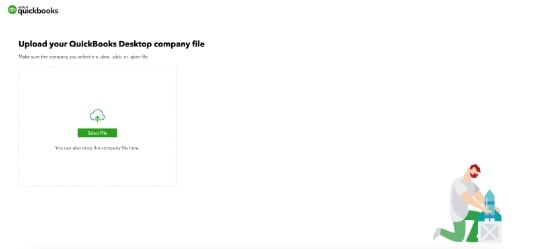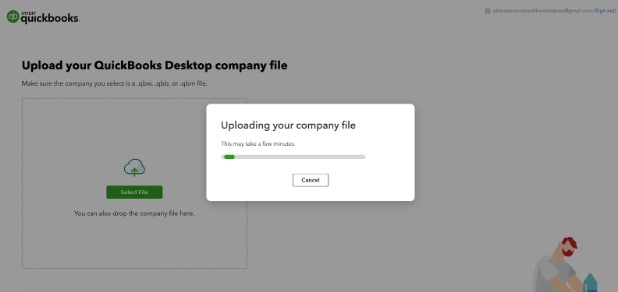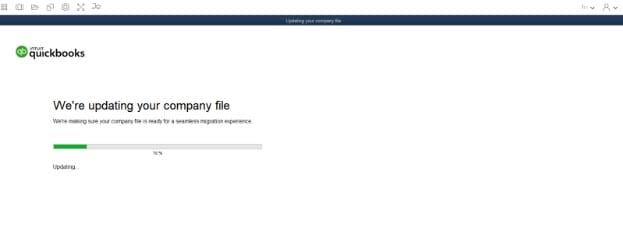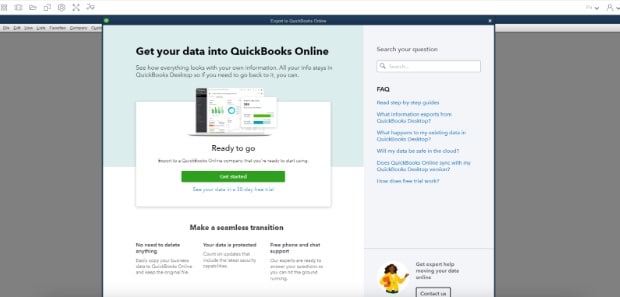Move your QuickBooks Desktop file to QuickBooks Online
by Intuit•20• Updated 3 days ago
Follow these steps to move from QuickBooks Desktop Pro, Premier, and Enterprise to QuickBooks Online.
Prerequisites
Make sure you’ve researched and signed up for a QuickBooks Online subscription before you start to move your data. Need a consultation to help pick the right plan for your needs? Call 1-888-829-8589 to help you find the right solution or check out these resources:
To get started with your migration, you’ll need an active QuickBooks Online account. If you’re not sure which QuickBooks Online is right for you, check out these resources:
Note: You have 60 days from the time you create your QuickBooks Online account to move your data. If you’re not sure how old your company is, sign in to QuickBooks Online. Then, refresh this page for personalized info.
How long does it take to migrate? Migration time depends on a few things, like how complex and large your QuickBooks Desktop file is.
What transfers from QuickBooks Desktop to QuickBooks Online? To learn more about names and what transfers, check out our comparison article.
Need more help? Check out the Move from QuickBooks Desktop to QuickBooks Online Resource Centre.
Move your file
Step 1: Make sure your company file isn’t too big to export
Each transaction in your file links to every other entry. An invoice, for example, links to the customer and each item, account, estimate, sales tax, and payment. To move data to QuickBooks Online, the total links should be less than 2,500,000. To check, press Ctrl+1 or F2 on your keyboard.
If you’re over 2,500,000 targets, here’s what to do:
- Use the Lists and Balances or Lists Only options when you migrate.
- Manually enter your opening balances in a new QuickBooks Online file.
Step 2: Get your desktop file ready
- Make sure QuickBooks is up-to-date.
- Mark any customers, suppliers, or accounts you don't use as inactive. This'll clean up the data you moved to QuickBooks Online.
- Delete or void unbilled charges and unbilled time associated with inactive accounts, customers, suppliers, or employees. To delete unbilled charges, Go to Suppliers and select Bills.
- If you use online banking or import bank transactions, make sure to categorize and reconcile bank and credit card statements/transaction. To do so,
- Go to Banking, select Bank Feeds, then select Set up Bank Feed for an Account.
- If you use QuickBooks Desktop Payroll:
- Terminate or deactivate any employees you haven't paid in the current year.
- Make sure Employee profile info (first, last name, SIN, Date of Birth, Hire Date and Address) is available and updated for all employees.
- Wait 2–3 days after you've run payroll to move your data. This helps make all your paycheque info transfer over to QuickBooks Online. Then, move your data before your next payroll.
Note: Make sure to move your data at least a few days before your next payroll run. This'll give you time to finish the setup for QuickBooks Online Payroll.
- If you use QuickBooks Time, contact us for help to set up your account in QuickBooks Online.
Step 3: Move your QuickBooks Desktop file to QuickBooks Online
You have two options to move your data.
| Important: If your QuickBooks Desktop version is 2021 or older or you don’t have access to QuickBooks Desktop, you'll have to use the web-based migration tool. |
- Sign in as an admin in QuickBooks Desktop.
- Export your QuickBooks Desktop company:
- In QuickBooks Desktop Pro and Premier, go to Company and select Export Your Company File to QuickBooks Online.
- In QuickBooks Desktop Enterprise, press CTRL + 1 to open the Product information window. Then press CTRL + B + Q then select OK.
- Select Get started.
- You’ll see a screen that says "Let’s bring your data to QuickBooks Online". Select how you want to move your data:
- Bring all of your company data.
- Bring only lists and balances. (This option is helpful if you have a large file and don’t want to bring over every individual transaction).
- Select Continue.
- If you have inventory, you can:
- Select Yes, track inventory using FIFO then select a starting date.
- Select No, don’t move inventory. You can move your inventory manually later.
- If you use multi-currency in QuickBooks Desktop, you’ll have to select a home currency.
- You will be asked if you have a QuickBooks Online account.
- If you do, select Yes, sign me in, then select Continue.
Note: This is the account you created when you purchased your QuickBooks Online solution in Step 1 Subscribe to QuickBooks Online. - If you have not selected a QuickBooks Online solution, you can select No, I need to create one. This will create a QuickBooks Online Advanced trial company. We recommend you go to Quickbooks.intuit.com/ca/ to buy the right QuickBooks Online version for your company before starting migration.
- If you do, select Yes, sign me in, then select Continue.
- On the next screen, you will be asked to sign in. Sign in using the same user ID and password associated with your QuickBooks Online subscription.
- You’ll see your QuickBooks Online company names and subscriptions listed. Select the company you want to move your data to.
- Select Continue, then select Export. You will see a progression bar as your data is moved over to QuickBooks Online.
Note: If you already have data in a QuickBooks Online account, QuickBooks will ask if you want to replace the existing data, follow the below steps. - Enter Agree in the text field, then select Replace.
- Select Yes, go ahead and replace the data, then select Replace.
Online migration tool
Use this option if:
- You have QuickBooks Desktop 2021 or older
- You don’t have access to QuickBooks Desktop
Note: Check out Learn how features and data move from QuickBooks Desktop to QuickBooks Online article to see what moves to QuickBooks Online.
Step 1: Open the online tool
- Select the link for your QuickBooks version (available in English only):
- Select Get started, then sign in with your Intuit Account.
Step 2: Upload your company file
Follow these steps to upload your company file.
- Select Select File, then browse to the supported QuickBooks Desktop file you want to move.
Note: You can only upload one file at a time.

- Select Open to upload the file or drag and drop your QuickBooks Desktop file to upload it.

- Once your file is uploaded, we’ll auto-update it to the latest version of QuickBooks Desktop.

- Next, you'll see an option to move to QuickBooks Online.
- Follow the on-screen instructions to guide you through the move to QuickBooks Online.

- If your books fail to update to QuickBooks Desktop or move to QuickBooks Online, contact customer support.
Your QuickBooks Desktop company data, or your selected lists and balances, is now available in your QuickBooks Online account.
Step 4: Get ready to use QuickBooks Online
To learn more about your Home Dashboard click here.
Follow this list of what to set up in your new QuickBooks Online company.
- Schedule a free 45 minutes session with one of our experts. We'll answer questions about your data move, show you around QuickBooks Online, and help you tackle everyday tasks. Check out the Move from QuickBooks Desktop to QuickBooks Online Resource Centre, where you can schedule your call.
- Check out this getting started info: Get started with QuickBooks Online and Get started and adjust settings after you sign up for QuickBooks Online.
- Connect your bank or credit card account.
- Create and send invoices to your customer.
Note: If you track sales tax, set up location-based sales tax in QuickBooks first. - Track your bills and learn how to pay them in QuickBooks.
- If you use payroll, check our article Get started with QuickBooks Online Payroll to help you set up and run your payroll in QuickBooks Online.
Related articles
- To learn more about QuickBooks Online navigation, see Understand the navigation menu in QuickBooks on the Intuit Platform.
More like this
- Move or reinstall QuickBooks Desktop to another computerby QuickBooks
- Move your company files to another computerby QuickBooks
- How to set up QuickBooks Desktop to work from homeby QuickBooks
- Can't open company file in QuickBooks Desktopby QuickBooks